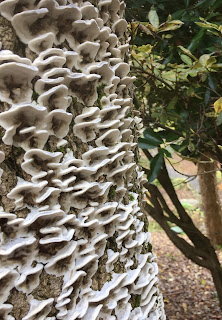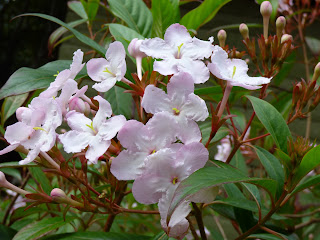Today I'm taking you to an art exhibition. I think you'll love it (unless you're into extreme modern art).
**************************************************
I motored to Adelaide recently. I was meeting my friend Maggie and we planned to visit the Clarice Beckett exhibition at the Art Gallery of South Australia. I was suitably excited and happily looking forward to the day ahead.

To set the scene: Clarice Beckett is today recognised as a significant figure in Australian modernist art, though during her lifetime (she was painting in the 1920s and 30s) her art was considered too controversial and avant-garde and certainly not the accepted art form of the day. She was thoroughly derided by prejudiced male artists and journalists, as were so many of her female contemporaries. Even her father was a critic and forbade her a studio, telling her she could use the kitchen table instead. However, Clarice rose above all this and indeed had quite a number of exhibitions - some of them garnering positive reviews, though no sales.
How do I know all this? We arrived at the exhibition just as tours were set to start, so we positioned ourselves with one of the groups and off we went with a guide. Guides are great because they give you insight into the artist, background knowledge and contextual information you wouldn't know about. Which is why I knew so much before we even started the tour proper.
It was an impressive beginning. I give thanks to Maggie for this photo; I was too excited to get going to think about taking a photo.
Beckett's style was termed 'tonalist' which meant muted colours, and diminished, ethereal light enhancing everyday scenes, generally on misty mornings and dusky early evenings, in rain and fog, at sunrise or moonlight.
I think these two of her paintings are a good example of what the tonalist movement was all about.
Our guide told us how Beckett would take a walk around her neighbourhood and paint whatever she saw, regardless of photographic or painting 'rules'. If there was a telegraph pole in the way, well, in that went, precisely where it was. If a tree was in the exact middle of the scene, then that's where she put it. People were often lone figures, shadows or insignificant, as in this next painting.
She did use colour, but sparingly. Her family had settled in the Melbourne bayside suburb of Beaumaris and many of her paintings were of nearby beach scenes, where blobs of colour catch the eye. Can you pick out the figure leading a horse in this next painting of Sandringham Beach?
Even though there is colour in the following painting, the overall impression is muted.
Strong vertical lines were also a feature of her work as in this next painting.
According to the guide, Beckett mostly painted en plein air and only went back home to touch up. She invented a trolley easel, making it easy for her to move around to different scenes at different locations and continue painting. Sadly, she died in 1935 aged 47, contracting pneumonia after painting at Beaumaris during a storm.
We now move forward to the 1970s when Rosalind Hollinrake, an art historian and gallery owner, began her research into the by-now forgotten Beckett. Her sister Hilda had stored about 2,000 of her paintings in an open-sided shed at Benalla in the foothills of Victoria's High Country, but they had been mostly destroyed by possums, other vermin and the weather. She managed to rescue about 369. Some more were discovered stored at Montsalvat, an artists' colony in Eltham, a suburb north of Melbourne. (I'm not sure how they ended up there as I didn't catch what the guide was saying as I was too absorbed in the paintings. Plus a number of reviews and articles about Beckett quote so many different figures for how many paintings were recovered it is hard to know what is true.) Anyway, a number of exhibitions of Beckett's work has been held since these paintings were restored, each one further cementing her work as one of Australia's foremost painters of the 1930s.
Our guide gave insights into the paintings as we wandered into the various display rooms, so we finished the tour knowing so much more. An endearing piece of information was that she had sometimes painted on cereal boxes - and there is one painting in the exhibition that shows this.
Time for a break. We bought a pot of tea (we chose one especially blended for the exhibition called, I think, Miss Beckett) that tasted to me of almonds, lemon and something spicy. Delicious.
Revived, we returned to the exhibition to take photos and look once more at the paintings with our new-found knowledge. The following one is of Anglesea Beach and I've recorded this in honour of my friend Kim who has a house at Anglesea.
While landscapes were her choice of subject, she also did vases of flowers; there was also one portrait on display - of her sister Hilda. But it was the misty, almost ghostly, scenes in the rain that drew me in. All of her paintings need to be seen from afar and this was clearly evident in my favourite one (below). I stood quite close and saw only a thick sweep of blurry grey paint with two barely visible faint blobs of a lighter grey. There was no discernible image. But when I stood way back it was amazing. Emerging from the gloom is a car with glowing headlights. It seemed to be coming straight at me. How Beckett managed to capture this movement and ghostly atmosphere is a sign of her talent.

While Beckett is well-represented in the Art Gallery of South Australia, much of her work is in private collections. Our guide told us that actor Russell Crowe has a sizeable stash, but when we all went 'Oh, that's wonderful that he supports her', she said that he had said in an interview it was purely an investment. Hmm.
A great day and Maggie and I were still discussing what we had seen hours afterwards.
**********************
If you would like to read more, I found these sites interesting.























































